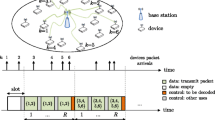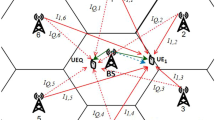Abstract
In this paper the contrasting effects of transmission impairments and capture on both the network and single user performance of a slotted Aloha system are investigated in a mobile radio environment, accounting for frequency non-selective random propagation phenomena, and employing the packet error probability in order to define packet losses and capture. With this study we demonstrate that it is possible to generalize in a real propagation context a method previously proposed in literature for evaluating the network behavior in terms of steady-state throughput, backlog and stability in conventional transmission conditions, i.e., when all the transmission channels were error-free and the collisions caused the loss of all the packets involved. Moreover, we indicate under which specific constraints on the terminal mobility we can apply this method to analytically predict the single user performance, which we show being an important design parameter. Through the numerical results reported we quantitatively point out that in the absence of coding capture increases system stability and moderately improves the overall system throughput and backlog. We also outline the trade-off between an increased capture gain obtained by means of coding and the corresponding system cost in terms of complexity and bandwidth occupancy. Furthermore, we demonstrate the unfairness which affects the single user performance and the consequent need for countermeasures in order not to discriminate among users differently located within the network; yet, this last solution is detrimental as regards the positive capture effects.
Similar content being viewed by others
References
L. Kleinrock and S.S. Lam, Packet switching in a multiaccess broadcast channel: Performance evaluation, IEEE Trans. Commun. 23 (1975) 410–423.
A.B. Carleial and M.E. Hellman, Bistable behavior of Aloha-type systems, IEEE Trans. Commun. 23 (1975) pp. 401–410.
C. Namislo, Analysis of mobile radio slotted ALOHA networks, IEEE Trans. Veh. Tech. 33 (1984) 199–204.
D.J. Goodman and A.A.M. Saleh, The near/far effect in local Aloha radio communications, IEEE Trans. Veh. Tech. 36 (1987) 19–27.
B.R. Ramamurthi, A.A.M. Saleh and D.J. Goodman, Perfect-capture Aloha for local radio communications, IEEE J. Select. Areas Commun. 5 (1987) 806–814.
J.C. Arnbak and W. Van Blitterswijk, Capacity of slotted-ALOHA in a Rayleigh fading channel, IEEE J. Select. Areas Commun. 5 (1987) 261–269.
I.M.I. Habbab, M. Kavehrad and C.E.W. Sundberg, ALOHA with capture over slow and fast fading radio channels with coding and diversity, IEEE J. Select. Areas Commun. 7 (1989) 79–88.
A.U.H. Sheikh, Y.-D. Yao and X. Wu, The impact of fast fading on Aloha system in the mobile environment, 39 th IEEE Veh. Tech. Conf. San Francisco, U.S.A., 1989, 804–808.
C. Van der Plas and J.P. Linnartz, Stability of mobile slotted Aloha network with Rayleigh fading, shadowing, and near-far effect, IEEE Trans. Veh. Tech. 39 (1990) 359–366.
A. Böttcher and M. Dippold, The capture effect in multiaccess communications — The Rayleigh and landmobile satellite channels, IEEE Trans. Commun. 41 (1993) 1364–1372.
D.J. Goodman and S.X. Wei, Efficiency of packet reservation multiple access, IEEE Trans. Veh. Tech. 40 (1991) 170–176.
S. Nanda, Analysis of packet reservation multiple access: Voice data integration for wireless networks,IEEE GLOBECOM '90 Conference Record, San Diego, U.S.A., 1990, 984–988.
W.-C. Wong, Packet-reservation multiple access in metropolitan microcellular radio environment, IEEE J. Select. Areas Commun. 11 (1993) 918–925.
A.S. Acampora and Z. Zhang, A throughput/delay comparison: Narrow band versus broadband wireless LAN's, IEEE Trans. Veh. Tech. 42 (1993) 266–273.
G. Immovilli and M.L. Merani, Effect of the transmission impairments on the performance of packet radio networks, Euro. Trans. Telecom. and Related Tech. 2 (1991) 481–492.
G. Immovilli and M.L. Merani, Outage probability in packet radio networks due to cochannel interferences and Rayleigh fading,IEEE MILCOM '91 Conf. Record, McLean, VA, U.S.A., (1991) 632–638.
J.G. Proakis,Digital Communications (New York, McGraw-Hill, 1983).
Y. Onozato and S. Noguchi, On the trashing cusp in slotted Aloha systems, IEEE Trans. Commun. 33 (1985) 1171–1182.
A. Papoulis,Probability, Random Variables and Stochastic Processes (McGraw-Hill, 1965).
Author information
Authors and Affiliations
Additional information
This work was supported by M.U.R.S.T. and C.N.R. (Italy).
Rights and permissions
About this article
Cite this article
Castoldi, P., Immovilli, G. & Merani, M.L. Network and single user performance evaluation of a mobile data system over flat fading transmission channels. Wireless Netw 1, 95–106 (1995). https://doi.org/10.1007/BF01196261
Received:
Issue Date:
DOI: https://doi.org/10.1007/BF01196261




